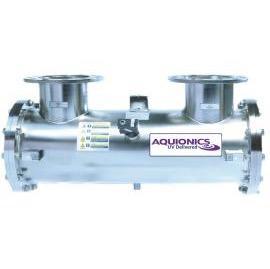

Sure, you have heard the buzz about using UV in your plant for disinfection, but let’s talk specifics…. How can you truly put UV to work in your plant, realize the benefits from the first step of your process AND justify the cost? It’s simple—put UV to work as a firewall in your plant to guarantee safe water for your process and FSMA compliance.
When we talk about water quality and disinfection in processing plants, we like to focus on three main issues:
Using UV technology as a firewall in your sanitary processing plant is your answer to these concerns.
Yes, the water is treated, but let’s talk about the distribution system for the treated water. According to a 2006 EPA study, more contamination events are due to issues with the distribution system than to source water contamination. But why?
Are you prepared and protected if a slug of dirty water makes contact with your plant? What would be the potential impact of using untreated water in your process or product? If you are thinking, “But we have never had a problem,” you aren’t alone. However, the number of food borne illnesses and hospitalizations is staggering. UV treatment of your process water as it comes in the plant protects both your product and your consumer.
Not only is safe water important for protecting your product, but it is an enforced regulation. According to the FSMA section 117.37(a), it is required that the water supply be sufficient for the operations intended and be derived from an adequate source. This leaves us with the question of “So is city water acceptable?” Of course it is acceptable, but how do you know?
There are two ways to know if city water is acceptable:
In order to truly comply with FSMA, the FDA will be looking at how processors are ensuring how guidelines are being met. This means documentation. The best way to meet the FSMA requirements for 117.37(a) is UV. UV provides real time measurement of dose, is easy to document and guarantees microbial inactivation.
Aside from possible regulatory pressure or concerns about the water supply, why would you want to implement UV as a firewall in your plant? Brand protection.
UV helps:
If bad water enters your plant and there is no treatment, what kind of impact could that have on your operation?
Do your plant’s practices hold up to FSMA compliance? Get the facts to see if what you are already doing is enough, or if adding UV to your disinfection process as a firewall would benefit your process.
We know that municipal water concerns are well documented, FSMA compliance is an upcoming hot topic and food safety is always a constant concern. Get ahead of the curve before FDA can ask questions about your lack of compliance and treat water before it has a chance to cause compliance and safety issues for your brand.
Guaranteed disinfection and safe water can provide invaluable peace of mind. Contact a Rodem representative today and see the small price to implement UV as a firewall and get this assurance for your process, product and consumers in the long run.
Special thank you to our UV partners at Aquionics for providing the content regarding using UV as a firewall for this article.
E-mail: [email protected]
Copyright 2024 Rodem Inc. All rights reserved.
